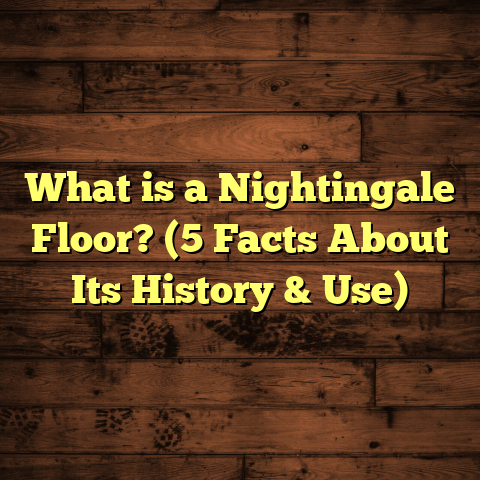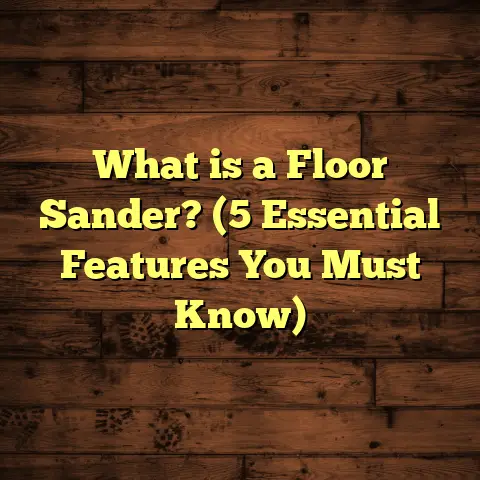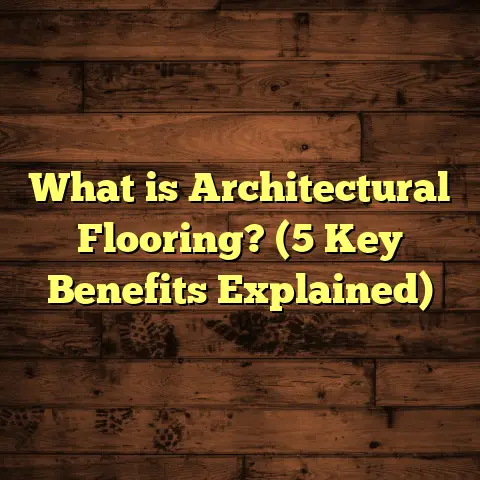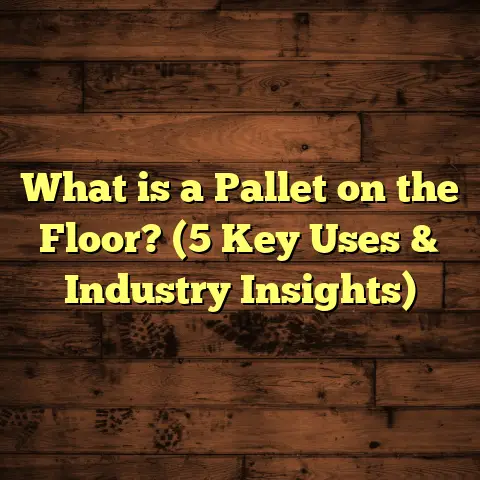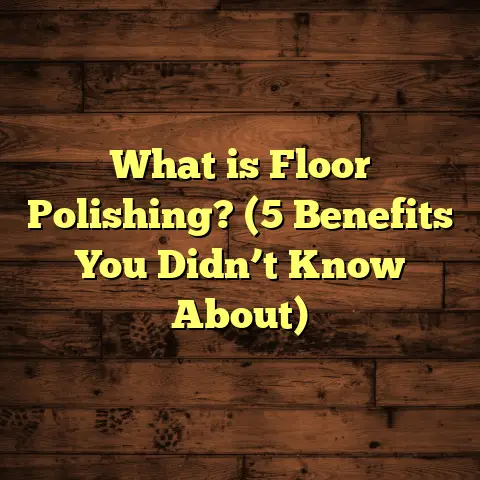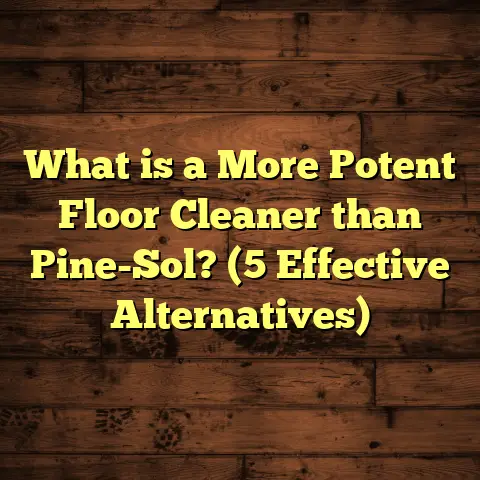What is the Cost to Install Luxury Vinyl Plank Flooring? (5 Key Factors to Consider)
What is Luxury Vinyl Plank Flooring?
When I first heard about luxury vinyl plank flooring, I thought it was just another version of vinyl flooring that you might see in old kitchens or basements. But after installing my first few projects, I quickly realized LVP is a totally different beast. It’s designed to look like real hardwood or stone but is built for durability, waterproofing, and ease of installation.
Luxury Vinyl Plank (LVP) is a type of resilient flooring made from multiple layers. Typically, it has a rigid core for stability, a high-quality photographic layer that mimics natural wood or stone patterns, and a tough wear layer on top that protects against scratches and stains. This makes it a fantastic option for busy homes, commercial spaces, or anywhere you want the look of wood without the maintenance headaches.
The best part? LVP is often waterproof or water-resistant, which means spills or moisture won’t ruin your floor the way they might with hardwood. When I installed LVP in my own kitchen, I was sold on how easy it was to mop up spills without worrying about damage.
Why Does Installing Luxury Vinyl Plank Flooring Cost What It Does?
You might be wondering why some quotes for LVP installation are $3 per square foot while others are $7 or more. The truth is, there’s no one-size-fits-all price. From my years working in flooring, I’ve learned that five main factors influence the total cost. Understanding these will help you avoid surprises and budget smartly.
1. Material Quality and Brand
Not all luxury vinyl planks are created equally. The price you pay depends heavily on the product’s quality, thickness, brand reputation, and warranty.
Thickness and Wear Layer
The thickness of the plank affects durability and feel underfoot. Most LVP planks range from 4 mm to 8 mm thick. Thicker planks feel more solid and can better mask subfloor imperfections.
The wear layer is the top protective coating measured in mils (thousandths of an inch). A thicker wear layer means better scratch resistance and longer lifespan. For example:
- 8 mil wear layer: Basic residential use; cheaper.
- 12-20 mil wear layer: Commercial-grade or heavy residential use; pricier but lasts longer.
In one of my projects with a client who had pets and kids, we chose a 20-mil wear layer for extra protection. The material cost was nearly double compared to a basic 8-mil alternative.
Brand Reputation
Brands like Shaw Floorté, COREtec, Armstrong, and Mohawk tend to charge more but offer longer warranties and more realistic textures. Lower-end brands might save you money upfront but may not last as long or look as good.
Data Insight: A 2024 flooring market report showed premium LVP brands can cost 50-70% more than budget brands but typically last 2-3 times longer before needing replacement.
Design Options
Some LVP offers hand-scraped wood textures, embossed grains, or multi-tone color variations that add realism but come at a premium price.
2. Installation Complexity
Installation isn’t just about laying down planks. The condition of your existing floor and room layout affect labor costs significantly.
Subfloor Condition
If your current floor is uneven, damaged, or has moisture issues, you’ll need subfloor prep work. This could mean leveling with a self-leveling compound or fixing cracks.
I remember a job where the concrete subfloor had minor cracks and uneven spots. We spent two days repairing it before installing LVP, which added $1.50 per square foot in labor costs.
If you want to save money here, make sure your subfloor is clean, dry, and level before installation.
Room Shape and Size
Large open rooms are easier to work in and usually cost less per square foot than smaller rooms with lots of corners or irregular shapes.
On one project in an older Victorian home with angled walls and multiple doorways, cutting and fitting took twice as long as normal, increasing labor costs by about 30%.
Installation Method
Most LVP uses floating click-lock installation which is faster and cheaper than glue-down methods. Glue-down can add $1-$2 per square foot but offers extra durability in some commercial settings.
3. Location and Labor Rates
Where you live makes a big difference in installation costs due to local wage rates and demand for contractors.
In cities like San Francisco or New York City, labor costs for flooring installation can easily reach $3-$4 per square foot or more because of higher living expenses and limited contractor availability.
Meanwhile, rural areas or smaller towns might have labor rates closer to $1.50-$2 per square foot.
I once worked on two similar projects—one in Chicago and one in a small town in Indiana. The Chicago job ran about $500 more overall just because of labor pricing differences.
Statistical Snapshot: According to the U.S. Bureau of Labor Statistics 2023 data:
- Flooring installers nationwide earn an average hourly wage of $20-$25.
- Urban areas often pay 15-30% above the national average.
- This directly impacts installation bids.
4. Additional Materials and Supplies
LVP installation requires more than just planks and labor. These extras can add $0.50 to $2 per square foot depending on what you choose.
Underlayment
Some LVP products have integrated underlayment; others require separate pads for soundproofing, moisture barriers, or extra cushioning.
For example, I installed LVP over concrete in a basement where moisture was a concern. We used a specialized vapor barrier underlayment costing $0.75/sq.ft to prevent mold issues later on.
Adhesives & Trims
While many modern LVP systems are floating floors that don’t need glue, some still require adhesive for certain applications (like glue-down installations).
Trim pieces such as baseboards, quarter-rounds, or transition strips between rooms are also necessary for a finished look. These often cost $1-$3 per linear foot installed.
Tools & Equipment
Professional installers bring specialized saws and tools for clean cuts. While this isn’t usually charged separately, some contractors include tool rental fees if the project is very small or DIY.
5. Waste Factor and Preparation Work
Don’t forget material waste—usually around 5-10%. Odd-shaped rooms generate more scrap because planks need cutting to fit corners or around doorways.
On average:
- Simple rectangular rooms: 5% waste.
- Complex layouts or diagonal installations: Up to 10% waste.
In a recent project with multiple closets and angles, we ended up ordering 12% extra material to avoid delays from needing more planks mid-installation.
Preparation work like moving furniture or removing old flooring adds time and cost too:
- Removing carpet averages $0.50-$1/sq.ft.
- Removing tile can be $2-$3/sq.ft depending on difficulty.
I had a client surprised by this when they only budgeted for new floor materials but didn’t plan for old floor removal fees.
Real Project Breakdown: How I Calculate Total Costs
To make this clearer, let me walk you through a real project I managed recently.
Project Details:
- Area: 1,200 square feet
- Material: Mid-range LVP at $3.75/sq.ft with 12-mil wear layer
- Labor: Average complexity at $2/sq.ft
- Underlayment: Included at $0.80/sq.ft
- Waste: 7% material overage
- Old floor removal: Carpet removal at $0.75/sq.ft
Here’s what the numbers looked like:
| Item | Cost per sq.ft | Quantity (sq.ft) | Total Cost |
|---|---|---|---|
| LVP Material | $3.75 | 1,284 | $4,815 |
| Labor | $2.00 | 1,200 | $2,400 |
| Underlayment | $0.80 | 1,200 | $960 |
| Carpet Removal | $0.75 | 1,200 | $900 |
| Total | $9,075 |
The $9,075 total works out to roughly $7.56 per square foot installed — which is right in line with regional averages for this scope.
I always advise clients to expect around this range unless they pick very budget or ultra-premium options.
Comparing Luxury Vinyl Plank Flooring to Other Popular Flooring Types
People often ask me how LVP stacks up against hardwood, laminate, tile, or carpet cost-wise and performance-wise:
| Flooring Type | Installed Cost Range (per sq.ft) | Durability | Maintenance | Water Resistance |
|---|---|---|---|---|
| Solid Hardwood | $6 – $12 | High (can scratch) | Requires refinishing | Low |
| Engineered Hardwood | $5 – $10 | Good | Moderate | Low |
| Ceramic/Porcelain Tile | $5 – $15 | Very High | Easy | Excellent |
| Laminate Flooring | $2 – $5 | Moderate | Moderate | Low |
| Luxury Vinyl Plank | $2 – $8 | High | Easy | Excellent |
| Carpet | $3 – $7 | Low | High (stains) | Low |
LVP hits a sweet spot: It’s cheaper than hardwood and tile while offering superior water resistance and simpler upkeep. When I advise clients with kids or pets who want wood looks but hate the upkeep hassle, LVP is my go-to recommendation.
Hidden Costs That Can Catch You Off Guard
In some projects I’ve handled over the years, clients got sticker shock because they hadn’t accounted for these less obvious expenses:
Subfloor Repairs
If your subfloor isn’t smooth or has moisture damage (common with concrete slabs), expect to pay for repairs or waterproofing membranes before installing LVP.
Furniture Moving Fees
Some contractors charge extra if you don’t move large pieces yourself. If you have bulky items like pianos or large sofas, consider this cost upfront.
Baseboards and Moldings
New flooring often requires replacing or reinstalling baseboards and trim for a polished finish. Custom molding can get pricey based on style.
Waste Disposal Fees
Removing old flooring can sometimes require hauling debris to disposal sites which may have tipping fees added by contractors.
How to Save Money Without Sacrificing Quality
I’ve helped many clients find ways to keep costs reasonable while still getting great floors:
- Choose mid-tier brands that balance durability with price.
- Clear furniture yourself ahead of time.
- Use floating click-lock planks to avoid adhesive costs.
- Plan larger contiguous areas for bulk labor discounts.
- Get at least three quotes but watch out for extremely low bids that could indicate shortcuts.
Why I Recommend Using Online Tools Like FloorTally
One tool I use frequently to estimate costs is FloorTally. It lets me input room dimensions, select materials from extensive databases, factor in waste percentages, local labor rates, underlayment options — all in one place.
This saves time gathering multiple quotes manually and helps visualize where your money goes. If you want an idea before calling contractors around you, FloorTally can give a pretty accurate ballpark figure based on current local prices.
Personal Stories: Lessons from My Flooring Jobs
Let me share two quick stories to put this all into perspective:
Story One: The Surprise Subfloor Repair
I was installing LVP in an older home where the client wanted the cheapest possible option to save money. When we pulled up the carpet underneath, it turned out the plywood subfloor had water damage in one corner that wasn’t disclosed initially.
We had to replace that section plus add moisture barrier underlayment costing an extra $700 on top of the original quote. The client learned that sometimes cutting corners on initial inspection can backfire financially later.
Story Two: Choosing Quality Pays Off Long-Term
Another client went with a premium brand with a thick wear layer because she has three kids and two dogs. The upfront cost was higher by about $1.50/sq.ft compared to budget options.
After four years of heavy wear—kids’ spills, pet claws—the floor still looked great with no scratches or lifting edges. She told me she was happy she invested more initially rather than having to replace floors prematurely like her neighbor did.
Final Thoughts on Budgeting Your LVP Flooring Project
From my experience:
- Expect material costs between $2 and $6 per square foot based on quality.
- Labor ranges from $1 to $4 per square foot depending on complexity.
- Don’t forget underlayment ($0-$1/ft²), waste (5-10%), removal fees ($0-$3/ft²), plus small extras like trims.
- Location plays a major role in pricing variability.
- Always plan for some surprise expenses—better safe than sorry!
If you want help estimating your project or figuring out what product fits your style and budget best, feel free to ask anytime! Whether you’re DIYing or hiring pros, being well-informed will help you get results you love without breaking the bank.
If you’d like me to create an estimate based on your specific room size and location using FloorTally or discuss brand recommendations tailored for your needs—I’m here to help!
